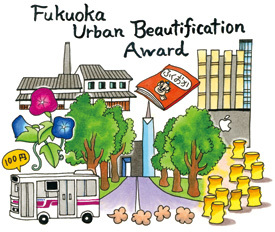Hakata Culture vol.28
The Urban Landscape of Fukuoka City

Fukuoka City began fulfilling its function as Kyushu’s core city circa 1976. That year marked the start of intense retail competition in the Tenjin area, as the Tenjin Underground Shopping Mall and Tenjin Station on the Fukuoka Municipal Subway line both opened. The Tenjin Core building and what is now Vivre opened at the same time. Opening the Tenjin subway line resulted in a major shift in the flow of people in the central part of the city. The flow had formerly been along Meiji-dori on an east-west axis, but shifted to Watanabe-dori on a north-south axis.
Ten years later, in 1987―during the bubble economy era―the city enacted legislation that focused on the urban landscape. The impetus came from the citizens who thought comfort and aesthetics in the city were more important than functionality and efficiency. The Fukuoka City Urban Landscape Award was also established to recognize those who contributed to the creation of an appealing urban landscape and to heighten the awareness of the urban landscape among the population.
In 2006, the Fukuoka City Landscape Award celebrated its 20th anniversary. A total of 20 photographs were selected each year from many submitted for consideration. In addition to unique buildings, structures, and monuments, awards are also given based on the consideration of a district’s planning and activities. The first awards were presented to Hotel Uminonakamichi and the main branch of Fukuoka Bank. Also receiving recognition were the Hakata Hyakunengura, a stone sake brewery in the Hakata Ward, and Daimyo’s Jokyu Soy Sauce supplier.
Other sites that have been recognized include the trees at Kego Primary School, the Museum City Project, and Hakata Tomyo. Even City Joho Fukuoka and the Nishitetsu 100 Yen Bus received awards! In short, the Fukuoka City Urban Landscape Award focuses on media that encourages dynamism in the city and activities to help people enjoy Fukuoka and Hakata history through the entire landscape―not just the buildings in large developments or the scenery itself. Fukuoka’s urban landscape reflects the history of the city and the character of its residents. I hope Fukuoka City retains its urban diversity, rather than a monolithic entity.
A public relations manager
Kimiyo Sasaki
Landscape Award in 2009:
- Nagata Bakery at Hakozaki
- Coffee Kuroudo Kakura at Atago
- Kyushu University Ito Campus
- Keyaki Avenue
- Grass playground at Momochihama elementary school
- Flower field at Nokonoshima Island Park
- Scenery of Fukuoka from a ferry ride to Noko Island
- Bus Terrace (bus stop with advertisement poster displays)
福岡市の都市景観
福岡市が今のような九州の中枢都市としての機能を果たすようになる始まりは、1976年頃からでした。天神に福岡市営地下鉄の駅と連動する天神地下街が開業すると同時に、天神コアビルや現在のビブレがオープンした第1次流通戦争といわれた時代です。ちなみに、私の元の職場でもある『シティ情報ふくおか』の創刊も1976年でした。「情報の時代」と言われ始めた頃です。都心部の人の流れが東西軸(明治通り)から天神地下街ができたことにより、南北軸(渡辺通り)に大きく変わりました。
それから10年後、バブル景気の1987年、福岡市は機能性や効率性だけの都市ではなく「ゆとりや潤い」を求める市民の声を基に「福岡市都市景観条例」を制定しました。また景観形成に貢献した人たちを表彰し、市民の皆さんにも景観に対する認識を深めていただくために「福岡市都市景観賞」を創設しました。
そして2006年、福岡市都市景観賞は20周年を迎えました。毎年、多数の応募写真から20数件に絞って、審査委員全員で現地を一つずつ見て回って審査しています。特徴的なのは建築物や工作物、モニュメントだけではなく、企画や活動なども表彰の対象になっていることです。第1回の受賞はホテル海の中道や福岡銀行本店など。これまでに福岡市内の主立った建築物はほとんど受賞していますが、大きな建築物だけではなく、博多区にある石蔵酒造の「博多百年蔵」や大名の「ジョーキュウ醤油」も受賞しています。そして警固小学校の並木や、天神を美術館に!という思いを具現化した「ミュージアム・シティ・プロジェクト」、博多部を美しく彩る「博多灯明ウォッチング」、それになんと『シティ情報ふくおか』や西鉄100円バスも表彰されました。
つまり、福岡市都市景観賞は大規模な開発の建築物や景観だけではなく、福岡の街を元気にしてきたメディアや、景観を通して福岡・博多の歴史を楽しむ活動にも注目しているのです。景観はその都市の歴史や市民性を映し出すものです。新しいものと伝統、自然と人工物、福岡の街のおもしろさや楽しさは多様な表情をもっているところ。これからも、一元的ではなく、様々な要素がからみあってバランスを保っている都市でありたいものです。
福岡市広報課長 佐々木 喜美代
2009年の都市景観賞
- ナガタパン箱崎店
- 珈琲蔵人 珈蔵 愛宕店
- 九州大学伊都キャンパス
- けやき通り
- 百道浜小学校運動場の芝生
- のこのしまアイランドパークお花畑
- 能古島行きのフェリーから見た福岡の風景
- バステラス

